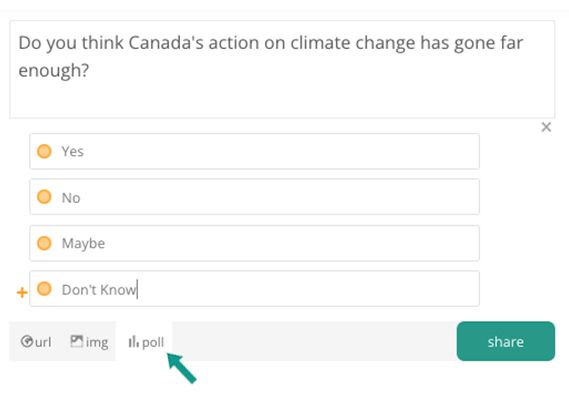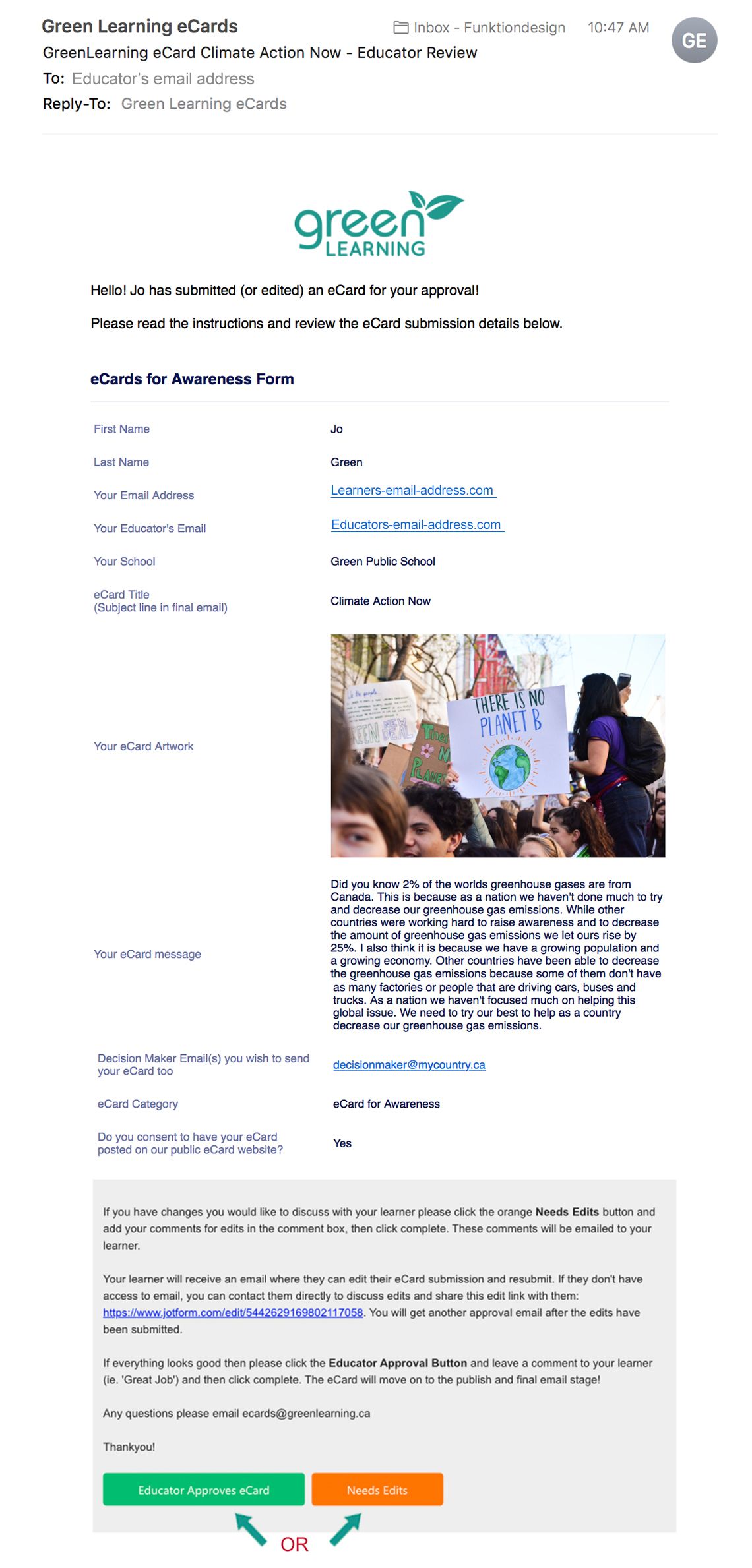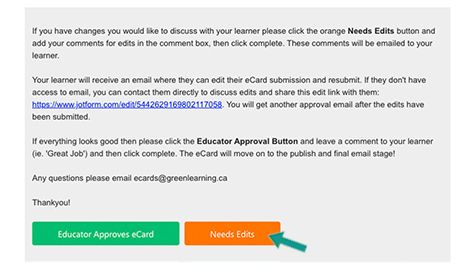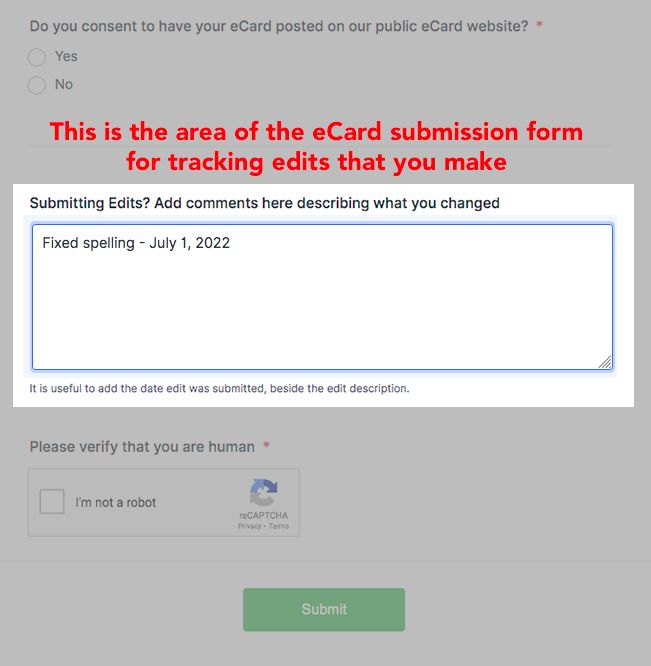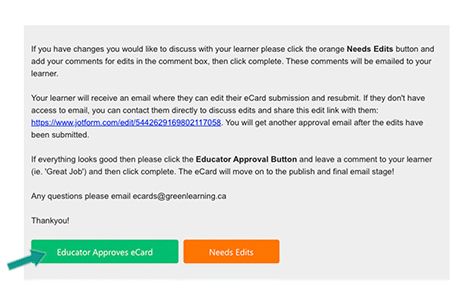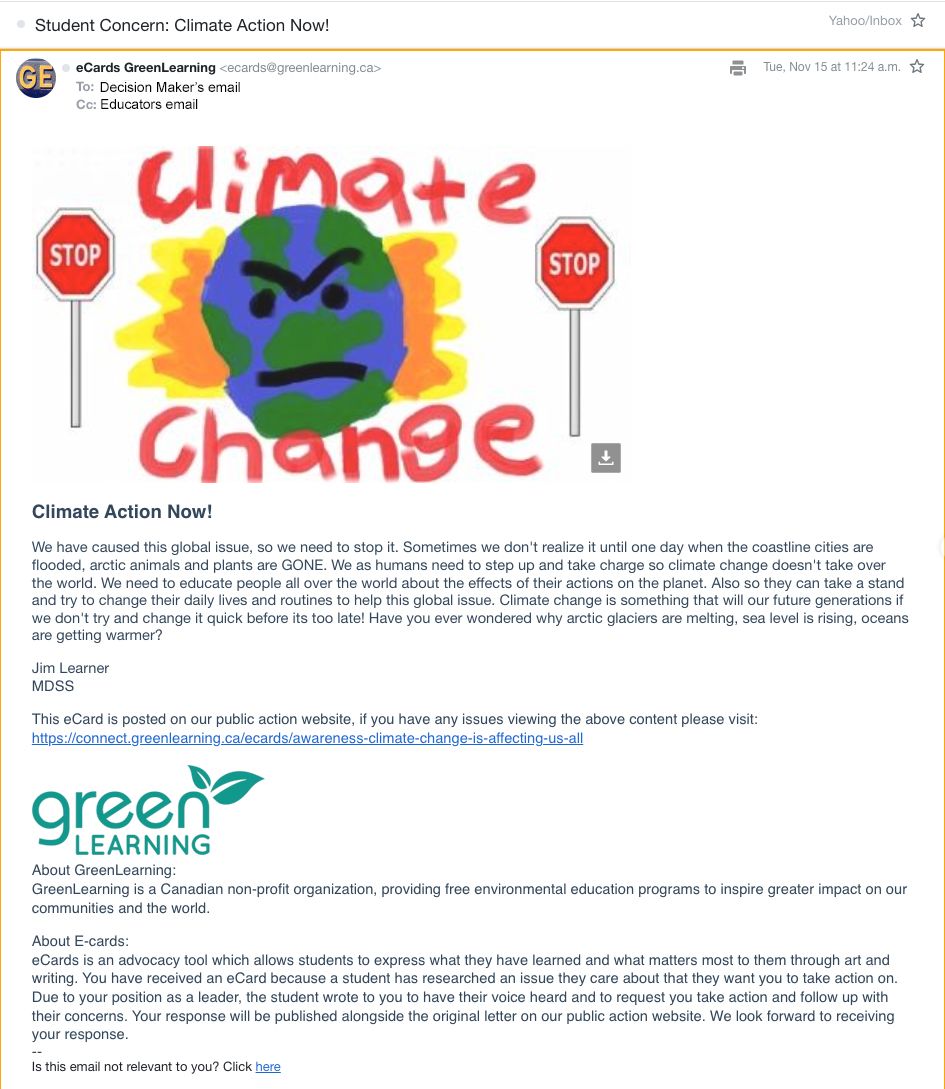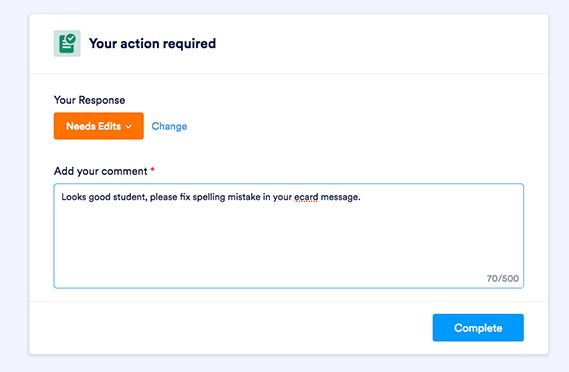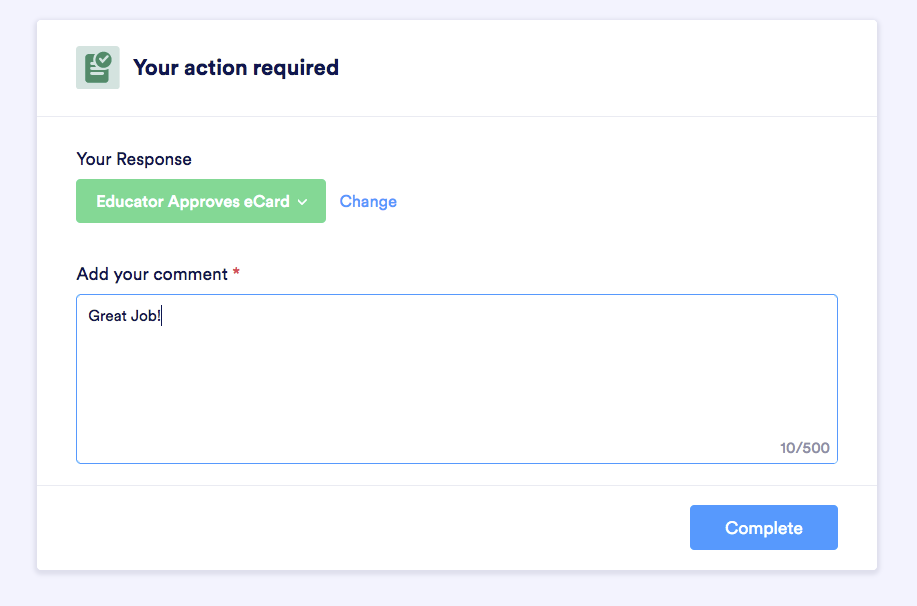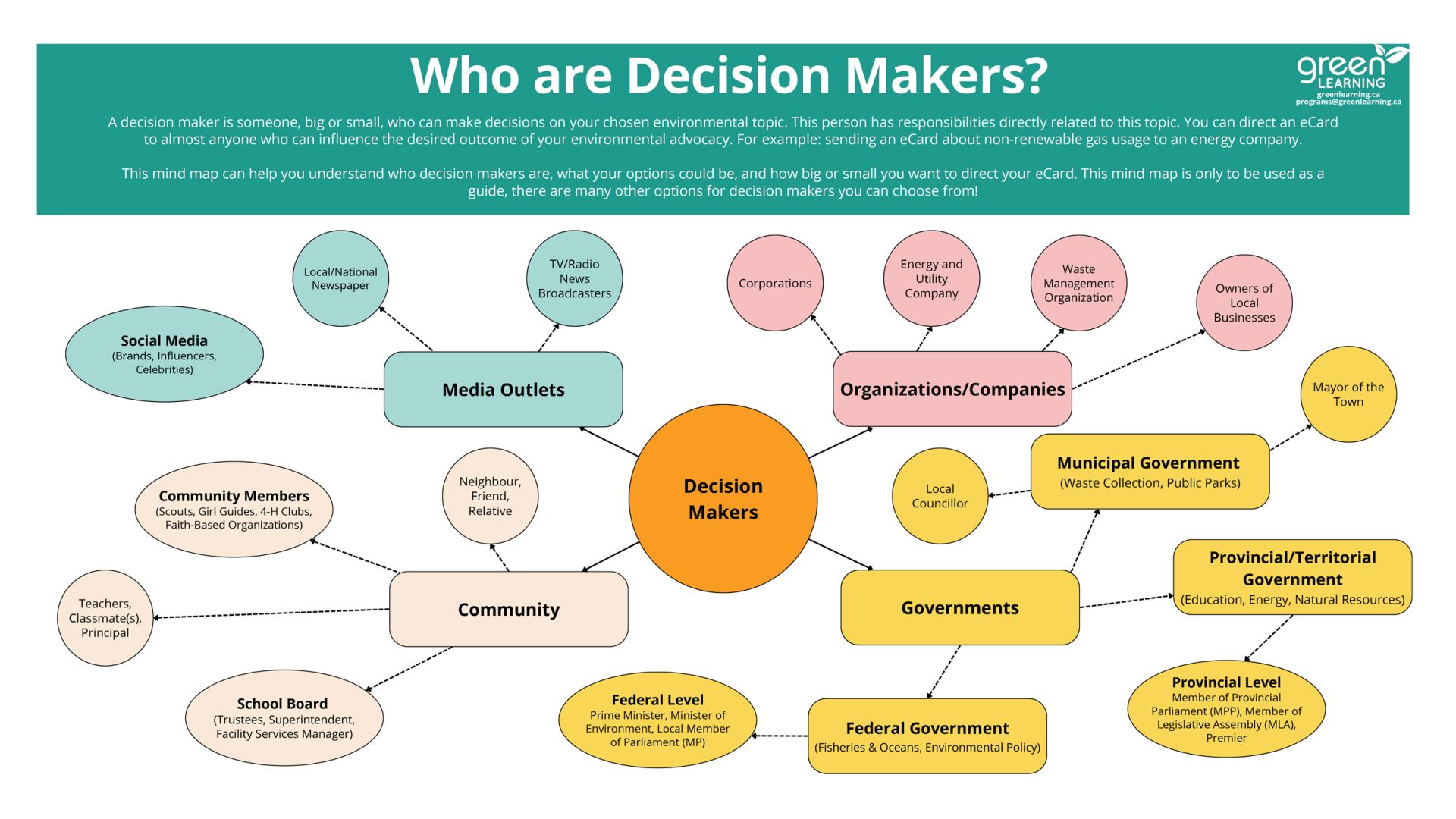2019 Re-Energy Solar Oven
Challenge Submission Showcase
Using a variety of recycled materials, these renewable energy engineers cooked everything from s'mores to nachos as they learned to harness some of the sun's energy through their solar ovens.
Brackendale Elementary School, Grade 4 Brackendale, British Columbia
Group 1:
To build our solar oven we used tin foil, tape, cardboard, paper, black paint, and corks. Our recycled materials were cardboard, paper, used plastic wrap, used tin foil, and corks. The potion of our materials that were recycled was 83.35%. The highest temperature our solar oven reached was 64 degrees Fahrenheit. We had corks and nobody else did. The day we tested this experiment, the weather was warm but also cloudy. In our solar oven we cooked cookies, they turned out really tasty and crispy, the chocolate was all the way melted.
Group 2:
We used: cardboard, glass, tape, a first aid blanket, styrofoam, pennies, black spray paint. We got the glass from the reuse centre and the cardboard was from our school we also got the styrofoam from our house. We added two sheets of glass and a magnifying glass. We also added lots of insolation that was made from styrofoam. Our solar oven got to 82 C it was on a warm day; the weather was 16. We made Rice Krispie squares, and cookies. We used our own recipes to make the Rice Krispie. We bought the cookie dough and then baked the Rice Krispie squares, and cookies. The cookies and Rice Krispies were really good!! We might do a bake sale at school with our solar ovens. We really enjoyed make the solar ovens and entering the contest!!
To build our solar oven we used tin foil, tape, cardboard, paper, black paint, and corks. Our recycled materials were cardboard, paper, used plastic wrap, used tin foil, and corks. The potion of our materials that were recycled was 83.35%. The highest temperature our solar oven reached was 64 degrees Fahrenheit. We had corks and nobody else did. The day we tested this experiment, the weather was warm but also cloudy. In our solar oven we cooked cookies, they turned out really tasty and crispy, the chocolate was all the way melted.
Group 2:
We used: cardboard, glass, tape, a first aid blanket, styrofoam, pennies, black spray paint. We got the glass from the reuse centre and the cardboard was from our school we also got the styrofoam from our house. We added two sheets of glass and a magnifying glass. We also added lots of insolation that was made from styrofoam. Our solar oven got to 82 C it was on a warm day; the weather was 16. We made Rice Krispie squares, and cookies. We used our own recipes to make the Rice Krispie. We bought the cookie dough and then baked the Rice Krispie squares, and cookies. The cookies and Rice Krispies were really good!! We might do a bake sale at school with our solar ovens. We really enjoyed make the solar ovens and entering the contest!!
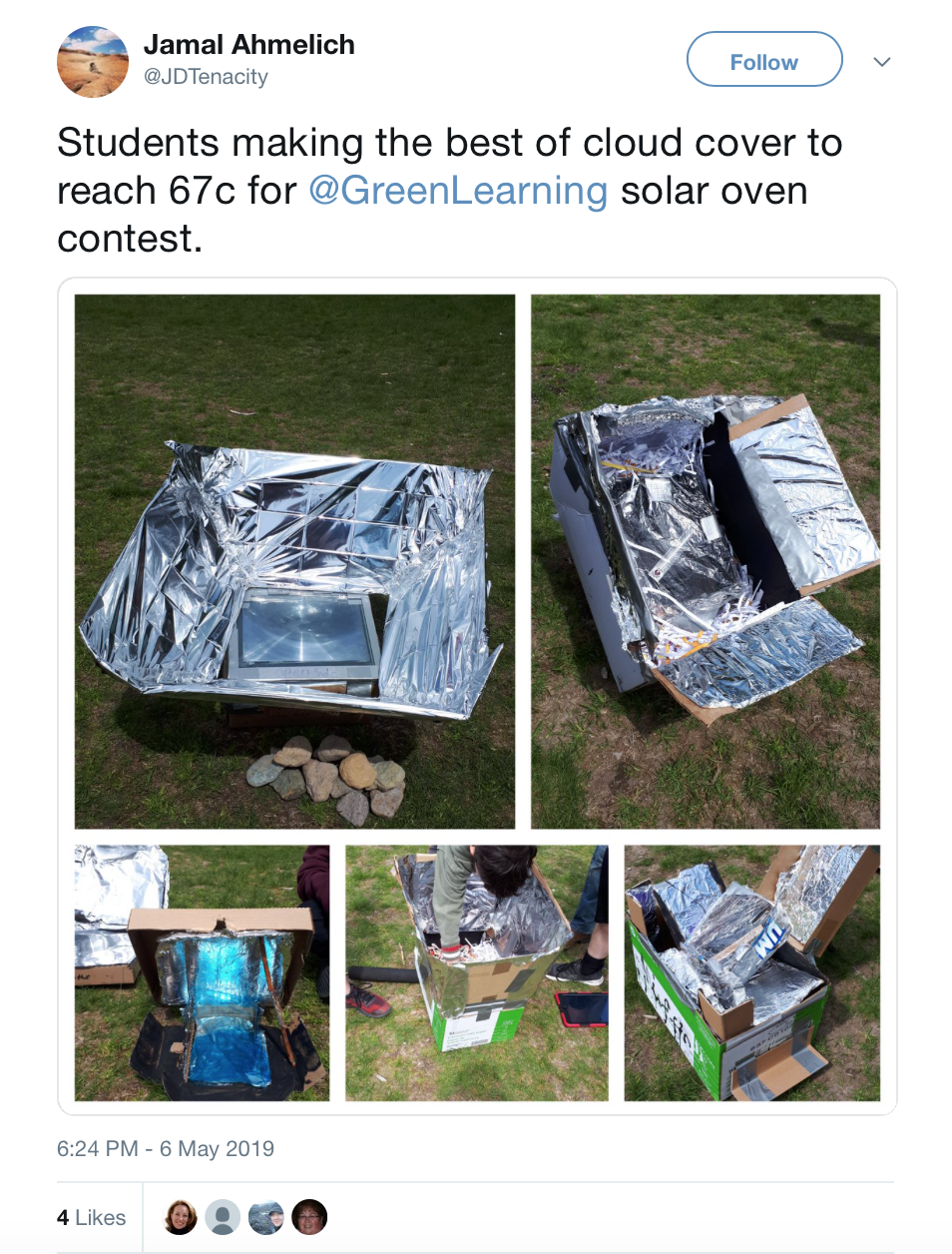
Caroline School, Grade 7
Caroline, Alberta
Group 1:
The cardboard and shredded paper we used were recycled. Our solar oven reached the temperature of 65 degrees Celsius. The temperature of the weather was 16 degrees Celsius. Our group cooked Cookies! At the start the cookies were all hard and the chocolate chips were frozen. After a while the cookies ended up melted and really hot. They were really hard to hold as well but they were delicious. Our solar oven had one unique feature so we took small pieces of tin foil and wrapped it around cardboard and painted it black. The experience was amazing and quite fun as well.
Group 2:
We used recycled cardboard, duct tape, recycled shredded paper, Saran wrap, black non-toxic paint. Tin foil, painter tape, tin food tray. Our oven reached 70 degrees Celsius. The weather was 19 degrees Celsius, there was a breeze as well. We cooked a frozen quesadilla, thawed in the microwave. We had a tin tray in an already boxed area, doubling the chances for heat to stay in the solar oven. It was a learning experience for everyone. Everyone got to see the different designs. We did enjoy this opportunity, it helped us develop an idea on how to go greener.
Group 3:
The materials I used are pizza boxes, Saran wrap, tinfoil, black cloths, paper shavings, and construction paper. The materials that were recycled were the pizza boxes, paper shavings, and the construction paper, so 3/6 was recycled. The solar oven went up to 70 degrees Celsius and I cooked nachos. Some unique things were the newspaper wrapped in black cloth, metal pan in the middle, a lid on the top, and the black paper on the outside. We invited the parents to come and watch. I really enjoyed making the Solar Oven! The whole experience has been really great and fun!
The cardboard and shredded paper we used were recycled. Our solar oven reached the temperature of 65 degrees Celsius. The temperature of the weather was 16 degrees Celsius. Our group cooked Cookies! At the start the cookies were all hard and the chocolate chips were frozen. After a while the cookies ended up melted and really hot. They were really hard to hold as well but they were delicious. Our solar oven had one unique feature so we took small pieces of tin foil and wrapped it around cardboard and painted it black. The experience was amazing and quite fun as well.
Group 2:
We used recycled cardboard, duct tape, recycled shredded paper, Saran wrap, black non-toxic paint. Tin foil, painter tape, tin food tray. Our oven reached 70 degrees Celsius. The weather was 19 degrees Celsius, there was a breeze as well. We cooked a frozen quesadilla, thawed in the microwave. We had a tin tray in an already boxed area, doubling the chances for heat to stay in the solar oven. It was a learning experience for everyone. Everyone got to see the different designs. We did enjoy this opportunity, it helped us develop an idea on how to go greener.
Group 3:
The materials I used are pizza boxes, Saran wrap, tinfoil, black cloths, paper shavings, and construction paper. The materials that were recycled were the pizza boxes, paper shavings, and the construction paper, so 3/6 was recycled. The solar oven went up to 70 degrees Celsius and I cooked nachos. Some unique things were the newspaper wrapped in black cloth, metal pan in the middle, a lid on the top, and the black paper on the outside. We invited the parents to come and watch. I really enjoyed making the Solar Oven! The whole experience has been really great and fun!
Chris Hadfield Public School, Grade 6
Milton, Ontario
We used cardboard that was mostly painted black, foil, duct tape, foil trays for the food, newspaper, and plastic wrap. The cardboard and newspaper were all recycled materials. So, for most of our ovens, about 50% of the total materials were recycled.
We had a good start to the day and after only about 20 minutes the temperature had risen to a maximum of 32 degrees Celsius. It was windy though and a couple of our taller designs got knocked over so they weren’t quite as warm. Unfortunately, when we checked on them a bit later, the bad weather had rolled in and it was cloudy until the end of school. We decided try it despite the weather and just see what would happen but the ovens just didn’t get hot enough. We enjoyed eating the leftover marshmallows and one of the groups had tested their recipe at home, so there were some cookies to share as well!
We tried a variety of different foods: nachos, chocolate filled crescent rolls, marshmallow filled cakes, and three different types of chocolate chip cookies. Two of the cookie recipes were homemade and almost the same basic recipe.
Most of our designs were fairly typical but varied in size and a few details like how much of the cardboard was painted and covered with foil. One of the more unique designs looks like an oven that you would have in your house. But it didn’t collect the heat as well because its design was too vertical and with not much sun didn’t get as hot as the others. We need to add better reflectors.
Most of our designs were fairly typical but varied in size and a few details like how much of the cardboard was painted and covered with foil. One of the more unique designs looks like an oven that you would have in your house. But it didn’t collect the heat as well because its design was too vertical and with not much sun didn’t get as hot as the others. We need to add better reflectors.
We had lots of fun with the challenge. We should have spent a bit more time planning some of our ovens and we hadn’t thought about how to best prepare some of the things we wanted to cook like how to get all those cookies downstairs and outside! We learned a lot about problem solving and working together and that duct tape is amazing! We liked the idea that if the ovens work we can build some during the summer and have fun with solar energy. We have talked about different sources of energy in our Science class and with Mrs. Stone. We now know how easy it is to use! We are looking forward to re-trying our ovens after Ramadan is over!
We had a good start to the day and after only about 20 minutes the temperature had risen to a maximum of 32 degrees Celsius. It was windy though and a couple of our taller designs got knocked over so they weren’t quite as warm. Unfortunately, when we checked on them a bit later, the bad weather had rolled in and it was cloudy until the end of school. We decided try it despite the weather and just see what would happen but the ovens just didn’t get hot enough. We enjoyed eating the leftover marshmallows and one of the groups had tested their recipe at home, so there were some cookies to share as well!
We tried a variety of different foods: nachos, chocolate filled crescent rolls, marshmallow filled cakes, and three different types of chocolate chip cookies. Two of the cookie recipes were homemade and almost the same basic recipe.
Most of our designs were fairly typical but varied in size and a few details like how much of the cardboard was painted and covered with foil. One of the more unique designs looks like an oven that you would have in your house. But it didn’t collect the heat as well because its design was too vertical and with not much sun didn’t get as hot as the others. We need to add better reflectors.
Most of our designs were fairly typical but varied in size and a few details like how much of the cardboard was painted and covered with foil. One of the more unique designs looks like an oven that you would have in your house. But it didn’t collect the heat as well because its design was too vertical and with not much sun didn’t get as hot as the others. We need to add better reflectors.
We had lots of fun with the challenge. We should have spent a bit more time planning some of our ovens and we hadn’t thought about how to best prepare some of the things we wanted to cook like how to get all those cookies downstairs and outside! We learned a lot about problem solving and working together and that duct tape is amazing! We liked the idea that if the ovens work we can build some during the summer and have fun with solar energy. We have talked about different sources of energy in our Science class and with Mrs. Stone. We now know how easy it is to use! We are looking forward to re-trying our ovens after Ramadan is over!
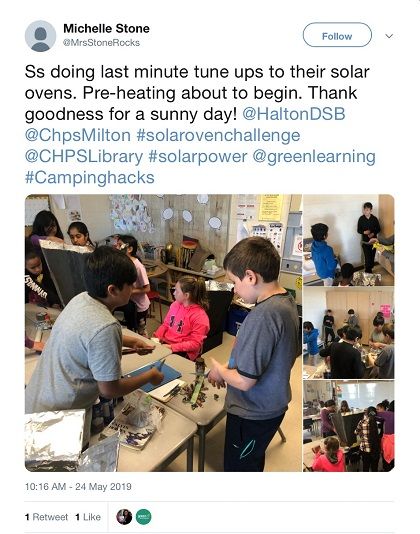
David Lloyd George, Grade 6
Vancouver, British Columbia
Group 1:
We used cardboard, black paper, aluminum foil, duct tape, Fresnel lens. All of those materials were recycled. The maximum temperature our solar oven reached was 115 degree Celsius on a sunny day with a bit of wind. We cooked nachos! Recipe: tomatoes, parsley, olive oil, lime juice, salt and pepper, tortilla chips and cheese. On our second test we cooked chocolate on top of a cream puff on top of a biscuit. On our final test we cooked a macaroon on top of cookie. We used black paper and spread it out at the bottom of the solar oven. We also used a Fresnel lens. On our final test day, we invited parents and our whole school to come and watch. At the end we cooked some pizza and shared it with some parents. I enjoyed GreenLearning’s Solar Oven Challenge!
Group 2:
We used recycled cardboard from our classroom – nobody needed them and it counts as recycled, aluminum foil, white glue, black paint, some recycled black paper. Our solar oven temperature got up to 110 degrees Celsius. It was pretty windy but it was really sunny. The wind sometimes will blow our oven down but the sun is really big today and it was sunny. We cooked nachos and pizza. The pizza is from our teacher for the parents and our nacho recipe we came up with. We used salsa, and another type of homemade sauce, tortilla chips, sour cream, tomatoes, green onions and cheese. We could open up the bottom flaps so it can make an angle to stalk the sun. The flaps for the lid can move around so it can reflect the sun to different angles. We also used our backpacks to make an angle to our oven. We put Fresnel lens on our oven so it can heat up faster. We put egg cartons under the Fresnel lens so it would catch on fire. We posted our oven on Instagram so that our friends and family will see this and think about going green. We also got other classes from the school to come take a look at our oven. After school, we got some parents to come and offered them pizza that we make from our oven. Almost all of the classes in our school came out to take a look at our ovens. 160 kids from our school came to look at our ovens. We want you to know we actually made two ovens. The first one was too small and it only got up to 50 degrees Celsius so we made another one! Our first one was really challenging and took us so long to figure out what to do but the second one was pretty easy. We really enjoyed making our own oven and the solar oven challenge.
Group 3:
We made our solar oven with Starbuck’s travel box (recycled) – frame, cardboard (recycled), recycled paper, insulation, black paint, tin foil, tape and glue. It was very windy and partly cloudy. The temperature reached 100 degrees Celsius but it might be higher as after we reached 100 degrees Celsius. We were preparing the food so we did not get a chance to check the temperature again. We made Rice Krispie balls dipped in chocolate with Rice Krisipes cereal, marshmallows, dark chocolate, white chocolate and optional coffee grounds. For the chocolate covered Oreos we used white chocolate, dark chocolate and Oreos. We drew/painted our solar system on our solar oven with the sun, planets, stars and cute little shooting starts. We also modified our ears/flaps to reflect more sunlight and we followed the model that my class from last year used. We also experimented with a Fresnel lens and it worked really well for my group and we learned quite a lot about Fresnel lenses and how to use them properly. Around 6 classes came by and saw our ovens and got treats from us as well as some teachers, parents and some passerby’s (we estimate about 180 people). My group learned a lot about solar energy and how we can use it in our daily life as well as taught people about it.
We used cardboard, black paper, aluminum foil, duct tape, Fresnel lens. All of those materials were recycled. The maximum temperature our solar oven reached was 115 degree Celsius on a sunny day with a bit of wind. We cooked nachos! Recipe: tomatoes, parsley, olive oil, lime juice, salt and pepper, tortilla chips and cheese. On our second test we cooked chocolate on top of a cream puff on top of a biscuit. On our final test we cooked a macaroon on top of cookie. We used black paper and spread it out at the bottom of the solar oven. We also used a Fresnel lens. On our final test day, we invited parents and our whole school to come and watch. At the end we cooked some pizza and shared it with some parents. I enjoyed GreenLearning’s Solar Oven Challenge!
Group 2:
We used recycled cardboard from our classroom – nobody needed them and it counts as recycled, aluminum foil, white glue, black paint, some recycled black paper. Our solar oven temperature got up to 110 degrees Celsius. It was pretty windy but it was really sunny. The wind sometimes will blow our oven down but the sun is really big today and it was sunny. We cooked nachos and pizza. The pizza is from our teacher for the parents and our nacho recipe we came up with. We used salsa, and another type of homemade sauce, tortilla chips, sour cream, tomatoes, green onions and cheese. We could open up the bottom flaps so it can make an angle to stalk the sun. The flaps for the lid can move around so it can reflect the sun to different angles. We also used our backpacks to make an angle to our oven. We put Fresnel lens on our oven so it can heat up faster. We put egg cartons under the Fresnel lens so it would catch on fire. We posted our oven on Instagram so that our friends and family will see this and think about going green. We also got other classes from the school to come take a look at our oven. After school, we got some parents to come and offered them pizza that we make from our oven. Almost all of the classes in our school came out to take a look at our ovens. 160 kids from our school came to look at our ovens. We want you to know we actually made two ovens. The first one was too small and it only got up to 50 degrees Celsius so we made another one! Our first one was really challenging and took us so long to figure out what to do but the second one was pretty easy. We really enjoyed making our own oven and the solar oven challenge.
Group 3:
We made our solar oven with Starbuck’s travel box (recycled) – frame, cardboard (recycled), recycled paper, insulation, black paint, tin foil, tape and glue. It was very windy and partly cloudy. The temperature reached 100 degrees Celsius but it might be higher as after we reached 100 degrees Celsius. We were preparing the food so we did not get a chance to check the temperature again. We made Rice Krispie balls dipped in chocolate with Rice Krisipes cereal, marshmallows, dark chocolate, white chocolate and optional coffee grounds. For the chocolate covered Oreos we used white chocolate, dark chocolate and Oreos. We drew/painted our solar system on our solar oven with the sun, planets, stars and cute little shooting starts. We also modified our ears/flaps to reflect more sunlight and we followed the model that my class from last year used. We also experimented with a Fresnel lens and it worked really well for my group and we learned quite a lot about Fresnel lenses and how to use them properly. Around 6 classes came by and saw our ovens and got treats from us as well as some teachers, parents and some passerby’s (we estimate about 180 people). My group learned a lot about solar energy and how we can use it in our daily life as well as taught people about it.
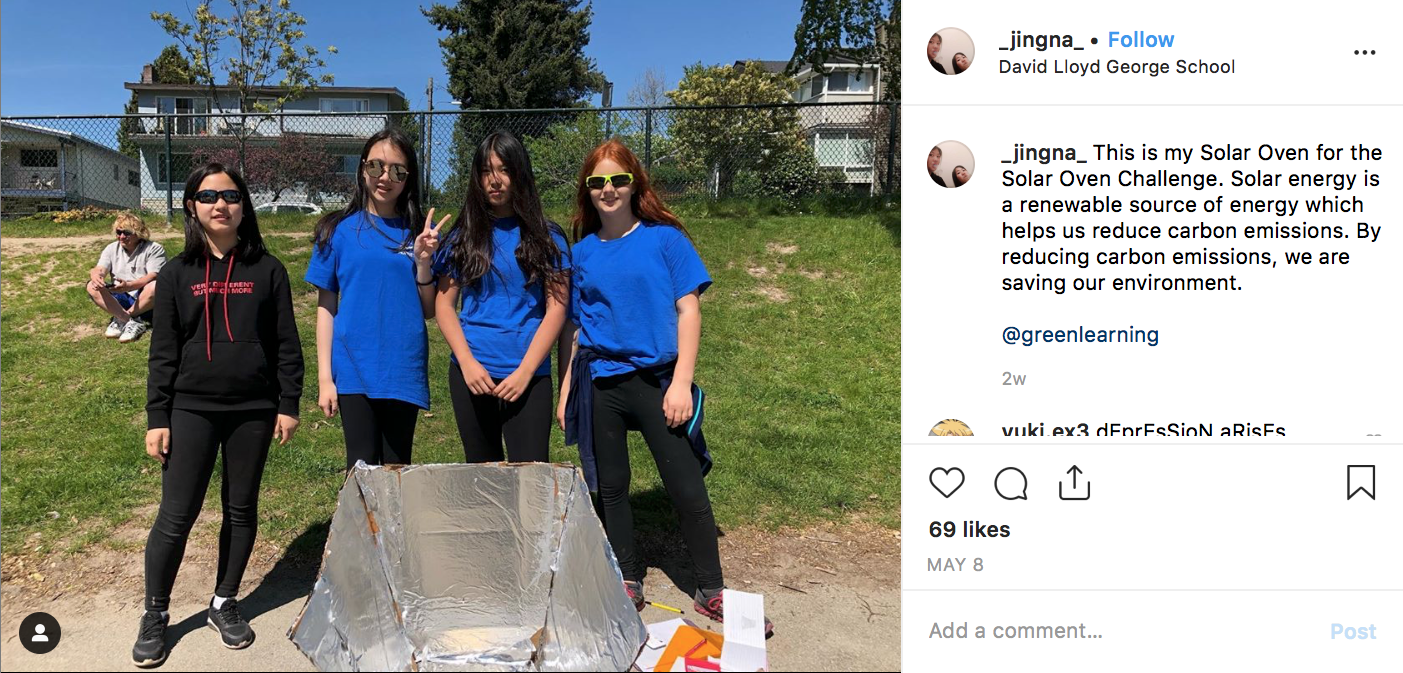
Hillside Public School, Grade 5
Mississauga, Ontario
Our winning solar oven was built using the packaging of an Acer computer box. It was cut up into 7 pieces to form a hexagonal shaped solar oven with a base. Black G.O.O.S. paper (aka - good on other side) was used as the inside base of the solar oven. Clear plastic from food packaging was added to the top of the solar oven to trap the heat inside. Tinfoil was also used in the construction.
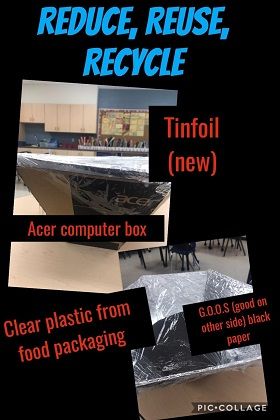
The highest temperature this solar oven reached was 108 degrees Celsius in just 20 minutes. It was 11 degrees Celsius outside. It was mostly sunny with a few clouds and a strong breeze.
We had several rounds and tests that the solar ovens needed to go through. The following recipes were cooked as per the round indicated:
Round 1 - S’mores
Ingredients: Marshmallows (halal and non halal), chocolate celebration cookies
Directions:
1. Place a celebration cookie chocolate side facing up in your solar oven.
2. Put a marshmallow on top
3. Place a celebration cookie chocolate side facing down on top of the marshmallow.
4. Cook until chocolate is starting to drip and marshmallow has started melted.
Round 2 - Lemon Coconut Chia Cookies
Ingredients: 2 tsp chia seeds, 1 cup quick oats, ½ cup coconut (unsweetened), 4 tbsp honey, 3 tbsp lemon juice
Directions:
1. Add all ingredients into a bowl and mix thoroughly.
2. With wet hands, shape mixture into balls that are approximately 2-3 cm.
3. Place on parchment paper in your solar oven.
4. Cook in your solar oven until cookie appears plump and is no longer sticky.
Round 3 - Banana Oat Cookies
Ingredients: 1 cup quick oats, 2 ripe bananas, handful of chocolate chips
Directions:
1. Add all ingredients into a bowl and mix thoroughly.
2. Shape mixture into balls that are approximately 2-3 cm.
3. Flatten balls with a fork.
4. Place on parchment paper in your solar oven.
5. Cook in your solar oven until cookie appears plump and is no longer sticky
This solar oven is unique in its shape. It is in the shape of a hexagon which allows for more foil panels to reflect the sun than the traditional square shaped solar oven. Its shape also helps when choosing how and where to place it to maximize its capabilities. For example, when using the solar oven early in the day, the sun is not as high in the sky. The angles of the 6 side panels also allows for this solar oven to be tipped on one of its sides to maximize the exposure to the sun.
This solar oven is unique in its shape. It is in the shape of a hexagon which allows for more foil panels to reflect the sun than the traditional square shaped solar oven. Its shape also helps when choosing how and where to place it to maximize its capabilities. For example, when using the solar oven early in the day, the sun is not as high in the sky. The angles of the 6 side panels also allows for this solar oven to be tipped on one of its sides to maximize the exposure to the sun.
I could not have been more impressed by this challenge and the learning opportunities it offered to my students. The students were extremely engaged and the learning that took place went beyond my expectations. I will definitely be signing up my grade 5 and grade 6 classes next year to participate in this incredible opportunity.
Next year, I am considering adding a social justice piece in. For example, “The United Nations Food and Agriculture Organization estimates that more than 3 billion people lack adequate cooking fuel.” How can you design an inexpensive solar oven that could provide for an entire village? Or alternatively, posing the question, “How could solar ovens be important for developing countries?”
We had several rounds and tests that the solar ovens needed to go through. The following recipes were cooked as per the round indicated:
Round 1 - S’mores
Ingredients: Marshmallows (halal and non halal), chocolate celebration cookies
Directions:
1. Place a celebration cookie chocolate side facing up in your solar oven.
2. Put a marshmallow on top
3. Place a celebration cookie chocolate side facing down on top of the marshmallow.
4. Cook until chocolate is starting to drip and marshmallow has started melted.
Round 2 - Lemon Coconut Chia Cookies
Ingredients: 2 tsp chia seeds, 1 cup quick oats, ½ cup coconut (unsweetened), 4 tbsp honey, 3 tbsp lemon juice
Directions:
1. Add all ingredients into a bowl and mix thoroughly.
2. With wet hands, shape mixture into balls that are approximately 2-3 cm.
3. Place on parchment paper in your solar oven.
4. Cook in your solar oven until cookie appears plump and is no longer sticky.
Round 3 - Banana Oat Cookies
Ingredients: 1 cup quick oats, 2 ripe bananas, handful of chocolate chips
Directions:
1. Add all ingredients into a bowl and mix thoroughly.
2. Shape mixture into balls that are approximately 2-3 cm.
3. Flatten balls with a fork.
4. Place on parchment paper in your solar oven.
5. Cook in your solar oven until cookie appears plump and is no longer sticky
This solar oven is unique in its shape. It is in the shape of a hexagon which allows for more foil panels to reflect the sun than the traditional square shaped solar oven. Its shape also helps when choosing how and where to place it to maximize its capabilities. For example, when using the solar oven early in the day, the sun is not as high in the sky. The angles of the 6 side panels also allows for this solar oven to be tipped on one of its sides to maximize the exposure to the sun.
This solar oven is unique in its shape. It is in the shape of a hexagon which allows for more foil panels to reflect the sun than the traditional square shaped solar oven. Its shape also helps when choosing how and where to place it to maximize its capabilities. For example, when using the solar oven early in the day, the sun is not as high in the sky. The angles of the 6 side panels also allows for this solar oven to be tipped on one of its sides to maximize the exposure to the sun.
I could not have been more impressed by this challenge and the learning opportunities it offered to my students. The students were extremely engaged and the learning that took place went beyond my expectations. I will definitely be signing up my grade 5 and grade 6 classes next year to participate in this incredible opportunity.
Next year, I am considering adding a social justice piece in. For example, “The United Nations Food and Agriculture Organization estimates that more than 3 billion people lack adequate cooking fuel.” How can you design an inexpensive solar oven that could provide for an entire village? Or alternatively, posing the question, “How could solar ovens be important for developing countries?”
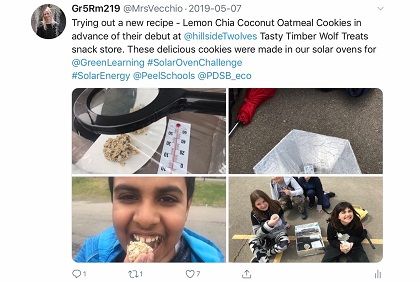
Humphrey Public School, Grade 7 and 8
Sequin, Ontario
Group 1:
We used duct tape, cardboard, shredded wood, tin foil, tin try, cardboard box and black paint. The weather was relatively cloudy with some periods of sun. The temperature outside was 16 degrees Celsius. Our oven reached 22 degrees Celsius. We choose to cook cookies! The insulation we chose was shredded wood instead of shredded paper. We had younger grades come out and visit our solar cookers and we explained what was happening to them. My group had a lot of fun and will love to do it again and it’s good to teach kids and adults that you can cook in a fun way while saving power.
Group 2:
The materials we used were cardboard, paint, tinfoil, pan, glue, clothes and wood. The maximum temperature reached was 37 degrees the weather day was Thursday, May 16, and the maximum temperature to start off with was 16. We cooked smores with graham crackers, marshmallows and chocolate. The outside was completely black so it would absorb more heat and the inside was covered in tin foil to attract the sunlight. Students came out to watch us cook. We got to tell them what we were making, it was fun. It was fun to cook this way, it was different.
Group 3:
We used cardboard, tin foil, tape and insolation. The temperature of the day was 16 degrees and the highest heat temperature it got to was 20 degrees. We made cookies and the little kids came out to see us cooking.
We used duct tape, cardboard, shredded wood, tin foil, tin try, cardboard box and black paint. The weather was relatively cloudy with some periods of sun. The temperature outside was 16 degrees Celsius. Our oven reached 22 degrees Celsius. We choose to cook cookies! The insulation we chose was shredded wood instead of shredded paper. We had younger grades come out and visit our solar cookers and we explained what was happening to them. My group had a lot of fun and will love to do it again and it’s good to teach kids and adults that you can cook in a fun way while saving power.
Group 2:
The materials we used were cardboard, paint, tinfoil, pan, glue, clothes and wood. The maximum temperature reached was 37 degrees the weather day was Thursday, May 16, and the maximum temperature to start off with was 16. We cooked smores with graham crackers, marshmallows and chocolate. The outside was completely black so it would absorb more heat and the inside was covered in tin foil to attract the sunlight. Students came out to watch us cook. We got to tell them what we were making, it was fun. It was fun to cook this way, it was different.
Group 3:
We used cardboard, tin foil, tape and insolation. The temperature of the day was 16 degrees and the highest heat temperature it got to was 20 degrees. We made cookies and the little kids came out to see us cooking.
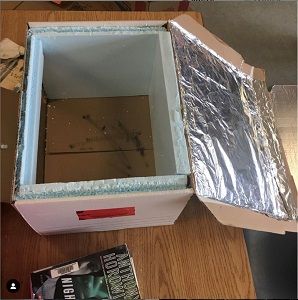
Lester B Pearson, Grade 7
Aurora, Ontario
We used recycled cardboard boxes, aluminum foil, newspaper and black paint. Some groups used recycled wood. We also used recycled glass that was also used from a picture frame. In addition, we used recycled magnifying glasses. One group even used a recycled pizza box. The majority of the materials were taken out of our school recycling bin. The only items we purchased were the black paint and the aluminum foil.
We made some amazing recipes. Our first recipe was nachos. We melted cheese and warmed salsa on our chips. We also melted chocolate and dipped marshmallows. Our final recipe was bannock with fruit on top and drizzled with maple syrup. We made this with our grade 3 and 4 reading buddies so that they could see how a solar oven works. One group made poutine.
When we used the solar ovens we baked some treats for our reading buddies in grade 3 and 4. We invited our reading buddies to have nachos with us as well as bannock with fruit and maple syrup. We made a connection with the grade 3 curriculum to First Nations. We also connected to grade 7 history curriculum. Our solar ovens were shared with the school community with our school newsletter that goes out electronically to all of our parents. Our solar ovens were also displayed for our Arts Night on the evening of May 1st. We also posted pictures on Instagram.
We used Instagram “ lesterb.solaroven” to showcase our solar ovens. We also published articles in our weekly school newletters that is sent to all of our parents/families. Our biggest challenge in Southern Ontario was the lack of sunshine and the amount of cold weather and continuous rain and cloud. We have had a very late spring. The leaves are just starting to finally open here. This made it extremely difficult to reach high temperatures with our solar ovens. Another factor, was the high winds that kept blowing over our solar ovens. Despite, all of these challenges, it was a blast!
We made some amazing recipes. Our first recipe was nachos. We melted cheese and warmed salsa on our chips. We also melted chocolate and dipped marshmallows. Our final recipe was bannock with fruit on top and drizzled with maple syrup. We made this with our grade 3 and 4 reading buddies so that they could see how a solar oven works. One group made poutine.
When we used the solar ovens we baked some treats for our reading buddies in grade 3 and 4. We invited our reading buddies to have nachos with us as well as bannock with fruit and maple syrup. We made a connection with the grade 3 curriculum to First Nations. We also connected to grade 7 history curriculum. Our solar ovens were shared with the school community with our school newsletter that goes out electronically to all of our parents. Our solar ovens were also displayed for our Arts Night on the evening of May 1st. We also posted pictures on Instagram.
We used Instagram “ lesterb.solaroven” to showcase our solar ovens. We also published articles in our weekly school newletters that is sent to all of our parents/families. Our biggest challenge in Southern Ontario was the lack of sunshine and the amount of cold weather and continuous rain and cloud. We have had a very late spring. The leaves are just starting to finally open here. This made it extremely difficult to reach high temperatures with our solar ovens. Another factor, was the high winds that kept blowing over our solar ovens. Despite, all of these challenges, it was a blast!
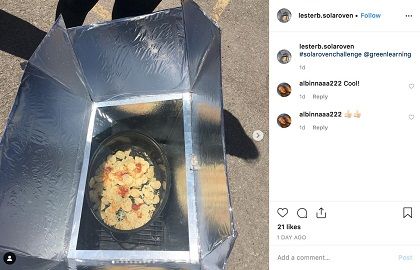
Nelson Waldorf School, Grade 5
Nelson, British Columbia
Group 1:
From home: We were able to measure the temperature after one hour and four minutes when we received the shared thermometer. At this point the oven had reached 71 degrees celsius. We then passed on the shared thermometer.
The weather that day was sunny, with clouds that did not block the sun from us, with no wind, it was warm but not scorching. The date was April 16th 2019. We tried to bake an egg, which did not cook very well. The top was hard an over cooked but the bottom was slightly gooey, although some of it was well cooked. We did not eat it because raw egg is not healthy to eat. We cooked it for one hour and 25 minutes.
From home: We were able to measure the temperature after one hour and four minutes when we received the shared thermometer. At this point the oven had reached 71 degrees celsius. We then passed on the shared thermometer.
The weather that day was sunny, with clouds that did not block the sun from us, with no wind, it was warm but not scorching. The date was April 16th 2019. We tried to bake an egg, which did not cook very well. The top was hard an over cooked but the bottom was slightly gooey, although some of it was well cooked. We did not eat it because raw egg is not healthy to eat. We cooked it for one hour and 25 minutes.
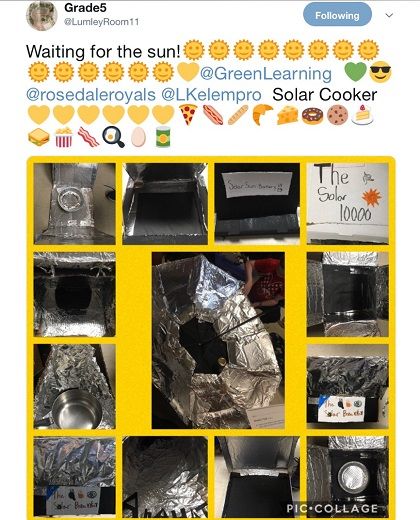
We used peace sign tape because we are spreading the message of peace and this is kind of peace with the earth. We also had two pie tins with styrofoam in the middle because one of them was deeper than the other, with foam on the outside and a ziploc bag cut down the sides we taped half way with one side of the bag so we could open it up half-way but still have it attached. The was how the baking chamber was made. We invited the classes to come by to look at our solar ovens in action. We used online references and both Aurora and Elise had discussions with their parents and each other about possible ideas. At first Aurora wanted to make Banana bread, but on further discussion realized hmmm, maybe not!, Aurora was curious how the egg would turn out, seeing as there often is eggs in baked goods, like Banana bread. Elise was keen on making a bean bake but was not sure if it work with the solar oven.
Group 2:
Our solar oven is made of all recycled materials except the tape. We cooked bannock in our solar oven. Bannock is a First Nations bread, made of flour, salt, baking powder, water and butter. Our solar oven is small and compact. It has two tin can utensil holders attached at its side. We used black river rocks to absorb heat in the oven. We invited our school to look at our solar oven. About 68 people looked at our oven and asked us questions.
Group 3:
My solar oven is made mostly out of recycled materials. I got a broken suitcase from the recycling depot. I got the window from a second-hand store. I got my stick from my walk home from the school bus. I used recycled styrofoam that my dad had. I used the recycled tin foil that we had around the house. I love creativity so it was really fun for me to make. I liked the fact that you have to design it and change it if you make a mistake. I had to design it two times. My solar was made out of a suitcase and it has a window. The other thing that is original is that it was made by me!! The stick was there to hold up the top of the solar oven so that the tin foil would reflect the light of the sun into the oven. The window was to keep the heat that it had collected in.
Our class shared our experience with the school. In assembly we told the other classes that we would be cooking in our solar ovens. The classes four, two, three, one and six and eight came to see. When one, two or three people came to my solar oven I would share my knowledge with them and told them about my experiences.
my recipe was ………………………………...PANCAKES
THIS IS THE EXACT RECIPE THAT I USED:
1 cup of flour
1 tsp of sugar
1sp of baking powder
1 pinch of salt
1 egg
1/2 cup of milk
Group 2:
Our solar oven is made of all recycled materials except the tape. We cooked bannock in our solar oven. Bannock is a First Nations bread, made of flour, salt, baking powder, water and butter. Our solar oven is small and compact. It has two tin can utensil holders attached at its side. We used black river rocks to absorb heat in the oven. We invited our school to look at our solar oven. About 68 people looked at our oven and asked us questions.
Group 3:
My solar oven is made mostly out of recycled materials. I got a broken suitcase from the recycling depot. I got the window from a second-hand store. I got my stick from my walk home from the school bus. I used recycled styrofoam that my dad had. I used the recycled tin foil that we had around the house. I love creativity so it was really fun for me to make. I liked the fact that you have to design it and change it if you make a mistake. I had to design it two times. My solar was made out of a suitcase and it has a window. The other thing that is original is that it was made by me!! The stick was there to hold up the top of the solar oven so that the tin foil would reflect the light of the sun into the oven. The window was to keep the heat that it had collected in.
Our class shared our experience with the school. In assembly we told the other classes that we would be cooking in our solar ovens. The classes four, two, three, one and six and eight came to see. When one, two or three people came to my solar oven I would share my knowledge with them and told them about my experiences.
my recipe was ………………………………...PANCAKES
THIS IS THE EXACT RECIPE THAT I USED:
1 cup of flour
1 tsp of sugar
1sp of baking powder
1 pinch of salt
1 egg
1/2 cup of milk
Rosedale Public School, Grade 5
Sarnia, Ontario
Welcome to our Solar Café 3019!
We created 22 different Solar Cookers. We then created a Solar Café Menu with great solar sun names. We cooked rice in the Anahat from way back in history. We created an umbrella cooker that held containers and a mason jar cooker. We used pizza boxes for Solar Cookies and Solar Cini Buns. We had turkey bacon and sausage sandwiches for the protein lovers.We baked cupcakes and Solar Ray Chocolate Cake. We melted caramels for our green Grannie Smith Apples. The caramel bubbled up and was delicious.We cooked Sunny Side Up Solar eggs in little black cups sitting on our Skateboard Ramp Cooker. We cooked hot dogs in a Pringle Can and a pizza box. We baked marshmallows almost like cooking them on a campfire.We had yummy s'mores treats melt perfectly in a shoe box cooker that was insulated with shredded paper. We baked cookies in the windshield of my vehicle as well. We used a black crockpot inside and large cooker we made following the directions on your GreenLearning site. The black crockpot and the muffin tin were so hot we could not pick them up with our hands. We made a hardboiled egg cooker with silver baking bowls. We used a tire from the kindergarten playground lined with tinfoil to bake our mini breads. The tire was really hot.One of our cooking teams cooked hot chocolate in Pringles cans. Our temperatures ranged from 15 to 34 degrees C. Our outside temperature was 14 today and we had full sun and a cool wind enough to keep blowing our menu of the wall!We learned that black skillets, glass and baking tins hold the most heat in our solar cookers. We learned the importance of slicing things thinly so that they don't stay doughy in the middle. It was important with the cake to use small containers to cook them in. Some of us learned the importance of sealing our cookers with plastic wrap so the heat would stay trapped inside. Painting our cookers black and using tinfoil was important to the temperatures we attained. Every hour we went outside to check our Solar Café to check the temperatures on the thermometers. We had a feast at the end of the day. We were very excited to watch our food change in shape, size and texture with the heat. We really couldn't believe how hot our cookers got. It was a great day and there was a lot of excitement in our grade 5 classroom!
We created 22 different Solar Cookers. We then created a Solar Café Menu with great solar sun names. We cooked rice in the Anahat from way back in history. We created an umbrella cooker that held containers and a mason jar cooker. We used pizza boxes for Solar Cookies and Solar Cini Buns. We had turkey bacon and sausage sandwiches for the protein lovers.We baked cupcakes and Solar Ray Chocolate Cake. We melted caramels for our green Grannie Smith Apples. The caramel bubbled up and was delicious.We cooked Sunny Side Up Solar eggs in little black cups sitting on our Skateboard Ramp Cooker. We cooked hot dogs in a Pringle Can and a pizza box. We baked marshmallows almost like cooking them on a campfire.We had yummy s'mores treats melt perfectly in a shoe box cooker that was insulated with shredded paper. We baked cookies in the windshield of my vehicle as well. We used a black crockpot inside and large cooker we made following the directions on your GreenLearning site. The black crockpot and the muffin tin were so hot we could not pick them up with our hands. We made a hardboiled egg cooker with silver baking bowls. We used a tire from the kindergarten playground lined with tinfoil to bake our mini breads. The tire was really hot.One of our cooking teams cooked hot chocolate in Pringles cans. Our temperatures ranged from 15 to 34 degrees C. Our outside temperature was 14 today and we had full sun and a cool wind enough to keep blowing our menu of the wall!We learned that black skillets, glass and baking tins hold the most heat in our solar cookers. We learned the importance of slicing things thinly so that they don't stay doughy in the middle. It was important with the cake to use small containers to cook them in. Some of us learned the importance of sealing our cookers with plastic wrap so the heat would stay trapped inside. Painting our cookers black and using tinfoil was important to the temperatures we attained. Every hour we went outside to check our Solar Café to check the temperatures on the thermometers. We had a feast at the end of the day. We were very excited to watch our food change in shape, size and texture with the heat. We really couldn't believe how hot our cookers got. It was a great day and there was a lot of excitement in our grade 5 classroom!
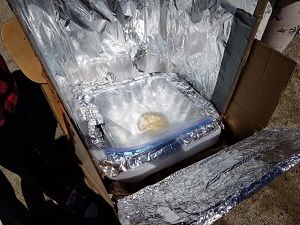
St. Marguerite Bourgeoys, Grade 7 and 8
Regina, Saskatchewan
Group 1:
Our solar oven reached a high temperature of 160 degrees F. the temperature outside was a low of 17 degrees C, and a high of 23 degrees C. although it was nice day for our solar ovens because it was sunny and warm, the 40 km wind made it difficult to keep our solar ovens standing and in proper condition. It was also hard to keep them at a steady temperature throughout the 3 hours. We chose to make a rainbow bit cake, from a Betty Crocker box. Although it was a pretty simple recipe, our oven didn’t reach hot enough temperatures to bake it. We made our solar oven at school as a class and invited the entire school to come around and check them out. Although not many classes did as it was very difficult to see what was happening in the boxes because they couldn’t get near them. We enjoyed the process of learning about green learning, and will continue to try to live a green life.
Group 2:
Our design had unique features such as a double insulator and we had extra different sizes. I think we could’ve reached a higher temperature if we added more, larger panels and a glass to keep more heat trapped inside while adding more heat to it, like an oven. We displayed our ovens on the basketball court from 12:00 PM to 3:00 PM. Once I saw it was up to 100 degrees Celsius, I couldn’t stop going back to check the temperature. The oven had two sets of insulators. The shredded paper was first put on the sides, then we sealed it up.
The second set was put under a cardboard cover, (at the bottom, then sealed up) the set was supposed to make the bottom hotter as the oven bag supports itself. The reflectors were quite small in comparison to the rest of the oven. As a result, it did not reflect too much heat on the oven. To solve this problem, my partner and I put the oven on an angle that faces the sun so that it gets a lot of sunlight. The reflectors’ angle was pointed towards the sun to make it even hotter; we rotated the oven 5 times that day to make it stable so that the oven can trap a reasonable amount of heat. We accidentally opened the oven bag and released all the heat and we had to restart the heat.
We put the Aluminum Container inside an Oven bag and the bag expanded, making heat inside the bag. Basically, a greenhouse effect by keeping heat inside the bag while storing even more heat as the day goes on. So basically, it’s an oven inside an oven. The reflectors supported the heat and pointed the heat towards the oven bag, and the oven bag was storing heat. The inside was painted black to absorb more heat and giving the oven a much hotter temperature and decreasing the time for cooking the food. And so was the pelt we cooked the food in. Overall, I think we did a good job on the solar oven.
Group 3:
We tested the solar oven on Wednesday May 21st the temperature was 17-24 degrees Celsius, and the wind was 40 km/h. The maximum temperature our solar oven reached was 80 degrees Celsius. Our oven was medium size, it was insulated with shredded paper and aluminum foil glued to cardboard as reflectors. We tried to bake banana cake, because the recipe we chose was very easy and nobody else was making the cake.
Our recipe was:
2 ¼ cups of flour,
¾ cups of brown sugar,
1 tablespoon of baking soda,
2 eggs,
1 pinch of salt,
4 ripe bananas (mashed),
½ cup unsalted butter,
2/3 cup butter milk,
and 1 cup of sugar.
We put all the dry ingredients in one bowl, and we mashed the bananas in the other and mashed them. Then, in the third bowl, we put room temperature butter, sugar and brown sugar, then mixed those together. After that, we put the mashed bananas into the butter mixture and then the dry ingredients and made this “cake” or “bread”. We put our banana cake into a metal tin and covered it with a plastic pan and put it in an oven bag. This system worked because the heat was trapping inside the closed oven bag ans it kept our cake warm and close to cooking. This was a very fun unit and thing to do, although our oven didn’t reach the heat we wanted, we were happy the oven worked and got to 80 degrees Celsius. We left our oven outside with the food in at around 11:30AM and it cooked until 3:00PM. I was very proud of my oven, even though it didn’t cook all the way I was still proud that me and my partner had finished our cake, the oven and we were happy. We used aluminum foil, black construction paper, shredded paper as insulation, saran wrap, a metal tin, an oven bag and cardboard.
Our solar oven reached a high temperature of 160 degrees F. the temperature outside was a low of 17 degrees C, and a high of 23 degrees C. although it was nice day for our solar ovens because it was sunny and warm, the 40 km wind made it difficult to keep our solar ovens standing and in proper condition. It was also hard to keep them at a steady temperature throughout the 3 hours. We chose to make a rainbow bit cake, from a Betty Crocker box. Although it was a pretty simple recipe, our oven didn’t reach hot enough temperatures to bake it. We made our solar oven at school as a class and invited the entire school to come around and check them out. Although not many classes did as it was very difficult to see what was happening in the boxes because they couldn’t get near them. We enjoyed the process of learning about green learning, and will continue to try to live a green life.
Group 2:
Our design had unique features such as a double insulator and we had extra different sizes. I think we could’ve reached a higher temperature if we added more, larger panels and a glass to keep more heat trapped inside while adding more heat to it, like an oven. We displayed our ovens on the basketball court from 12:00 PM to 3:00 PM. Once I saw it was up to 100 degrees Celsius, I couldn’t stop going back to check the temperature. The oven had two sets of insulators. The shredded paper was first put on the sides, then we sealed it up.
The second set was put under a cardboard cover, (at the bottom, then sealed up) the set was supposed to make the bottom hotter as the oven bag supports itself. The reflectors were quite small in comparison to the rest of the oven. As a result, it did not reflect too much heat on the oven. To solve this problem, my partner and I put the oven on an angle that faces the sun so that it gets a lot of sunlight. The reflectors’ angle was pointed towards the sun to make it even hotter; we rotated the oven 5 times that day to make it stable so that the oven can trap a reasonable amount of heat. We accidentally opened the oven bag and released all the heat and we had to restart the heat.
We put the Aluminum Container inside an Oven bag and the bag expanded, making heat inside the bag. Basically, a greenhouse effect by keeping heat inside the bag while storing even more heat as the day goes on. So basically, it’s an oven inside an oven. The reflectors supported the heat and pointed the heat towards the oven bag, and the oven bag was storing heat. The inside was painted black to absorb more heat and giving the oven a much hotter temperature and decreasing the time for cooking the food. And so was the pelt we cooked the food in. Overall, I think we did a good job on the solar oven.
Group 3:
We tested the solar oven on Wednesday May 21st the temperature was 17-24 degrees Celsius, and the wind was 40 km/h. The maximum temperature our solar oven reached was 80 degrees Celsius. Our oven was medium size, it was insulated with shredded paper and aluminum foil glued to cardboard as reflectors. We tried to bake banana cake, because the recipe we chose was very easy and nobody else was making the cake.
Our recipe was:
2 ¼ cups of flour,
¾ cups of brown sugar,
1 tablespoon of baking soda,
2 eggs,
1 pinch of salt,
4 ripe bananas (mashed),
½ cup unsalted butter,
2/3 cup butter milk,
and 1 cup of sugar.
We put all the dry ingredients in one bowl, and we mashed the bananas in the other and mashed them. Then, in the third bowl, we put room temperature butter, sugar and brown sugar, then mixed those together. After that, we put the mashed bananas into the butter mixture and then the dry ingredients and made this “cake” or “bread”. We put our banana cake into a metal tin and covered it with a plastic pan and put it in an oven bag. This system worked because the heat was trapping inside the closed oven bag ans it kept our cake warm and close to cooking. This was a very fun unit and thing to do, although our oven didn’t reach the heat we wanted, we were happy the oven worked and got to 80 degrees Celsius. We left our oven outside with the food in at around 11:30AM and it cooked until 3:00PM. I was very proud of my oven, even though it didn’t cook all the way I was still proud that me and my partner had finished our cake, the oven and we were happy. We used aluminum foil, black construction paper, shredded paper as insulation, saran wrap, a metal tin, an oven bag and cardboard.
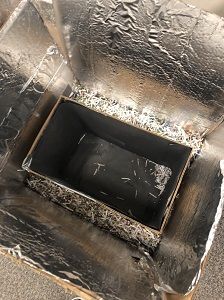
Whitby Shores Public School, Grade 7 and 8
Whitby, Ontario
At the end of every STEM project I give in Grade 7 and 8 at our school, we take apart our projects and salvage the reusable materials for our next projects (popsicle sticks, construction paper, plastic wrap, etc). In fact, a portion of the student’s grade at the end of the project is the reclamation process. This conscious action reinforces the idea for students that we have to keep the end of our product’s life cycle in mind and how we must consider our footprint in everything we do. This 21st century style of thinking is a deliberate action to teach our young engineers and scientists about the value of the entire engineering design process. These solar ovens will become the raw materials for student created hydraulic and pneumatic toys!
The weather on March 15, 2019 was cloudy, with the temperature outside 15 degrees with a slight breeze. The cloud cover generally remained for the 2 hours the ovens were outside. The oven that gained the most heat was 9 degrees, an impressive number considering the weather. While it did not melt the marshmallow, it did allow for a teachable moment where we talked about how solar energy can still be produced, despite lacking full sun exposure. We decided we will try these again in June as an end of the year cook-out.
We decided that because of the rainy and cool spring we have had, we decided to cook simple marshmallows. Our goal is to create better recipes and put these out again in June and have an end of year cook-out.
Whitby Shores Public School is a proud eco-school, with solar panels on our roof and an energy efficient heating system. We have eco-initiatives happening throughout the year, and many STEM related activities have an eco component. 3 Grade 7 classes participated in the challenge, as well as a Grade 1-2 class. We decided to invite the Grade 1-2 class to buddy up and build with one of the Grade 7 classes as well, sharing the goal of being eco-conscious. Our Grade 7s discussed heat transfer methods with the Grade 1-2s, and we explained the value of using the sun for energy. This also introduced the potential for STEM Buddies, instead of the traditional Reading Buddies. We placed our solar ovens at the front of the school, so the community could see the learning that was happening in our school. When we went outside to get out ovens, another grade 8 class joined us, totalling about 125 students outside in the front of the school.
We used our twitter to communicate our findings (@whitby_shores). Our twitter has 713 followers, including members of our parent community, local politicians, organizations, publications and community outreach programs. We sent out tweets on May 2, May 7, and May 16, detailing our progress. As of today (May 16), those tweets have encouraged 18 reactions online. The resources that you provided have been very helpful! I showed the class the outlines and the background information on solar energy. The students enjoyed the activity and it had enough choice imbedded in it that students could attack the problem from a variety of angles and abilities. I did this activity in one of my first years teaching and a student started a small fire! Great stuff. Thank you for providing the resources, this will be a project we complete next year as well.
The weather on March 15, 2019 was cloudy, with the temperature outside 15 degrees with a slight breeze. The cloud cover generally remained for the 2 hours the ovens were outside. The oven that gained the most heat was 9 degrees, an impressive number considering the weather. While it did not melt the marshmallow, it did allow for a teachable moment where we talked about how solar energy can still be produced, despite lacking full sun exposure. We decided we will try these again in June as an end of the year cook-out.
We decided that because of the rainy and cool spring we have had, we decided to cook simple marshmallows. Our goal is to create better recipes and put these out again in June and have an end of year cook-out.
Whitby Shores Public School is a proud eco-school, with solar panels on our roof and an energy efficient heating system. We have eco-initiatives happening throughout the year, and many STEM related activities have an eco component. 3 Grade 7 classes participated in the challenge, as well as a Grade 1-2 class. We decided to invite the Grade 1-2 class to buddy up and build with one of the Grade 7 classes as well, sharing the goal of being eco-conscious. Our Grade 7s discussed heat transfer methods with the Grade 1-2s, and we explained the value of using the sun for energy. This also introduced the potential for STEM Buddies, instead of the traditional Reading Buddies. We placed our solar ovens at the front of the school, so the community could see the learning that was happening in our school. When we went outside to get out ovens, another grade 8 class joined us, totalling about 125 students outside in the front of the school.
We used our twitter to communicate our findings (@whitby_shores). Our twitter has 713 followers, including members of our parent community, local politicians, organizations, publications and community outreach programs. We sent out tweets on May 2, May 7, and May 16, detailing our progress. As of today (May 16), those tweets have encouraged 18 reactions online. The resources that you provided have been very helpful! I showed the class the outlines and the background information on solar energy. The students enjoyed the activity and it had enough choice imbedded in it that students could attack the problem from a variety of angles and abilities. I did this activity in one of my first years teaching and a student started a small fire! Great stuff. Thank you for providing the resources, this will be a project we complete next year as well.
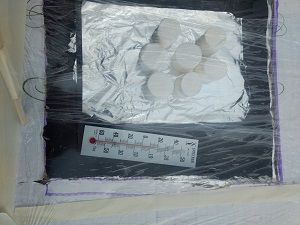
Wilflower School
Creston, British Columbia
Our class made sweet potato fries and cookies. We chose to use a pizza box for our solar oven because we wanted to use recycled materials. Our solar oven got up to 162 degrees. We invited others from our school community to come and taste the cooked recipes. We all enjoyed making our solar oven!
GreenLearning
creates free education programs about energy, climate change and green
economy that engage and empower students to create positive change.
Explore
Get Involved
© 2024 GreenLearning. All rights reserved.

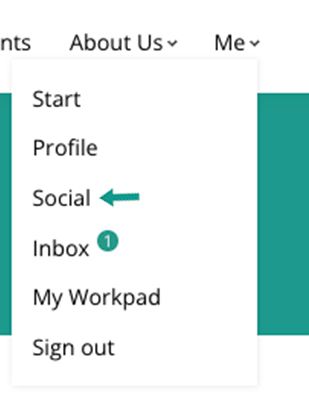
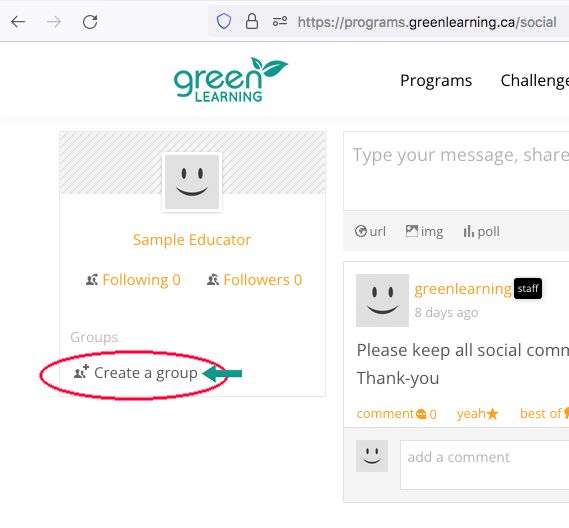
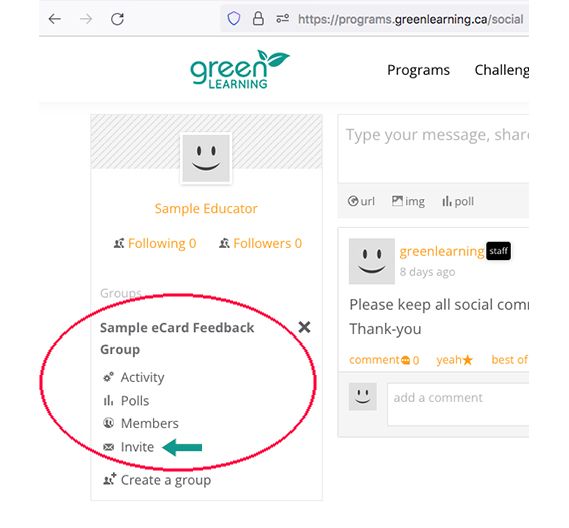
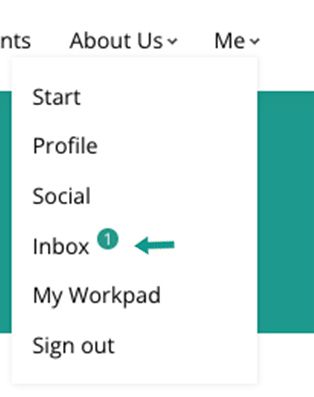
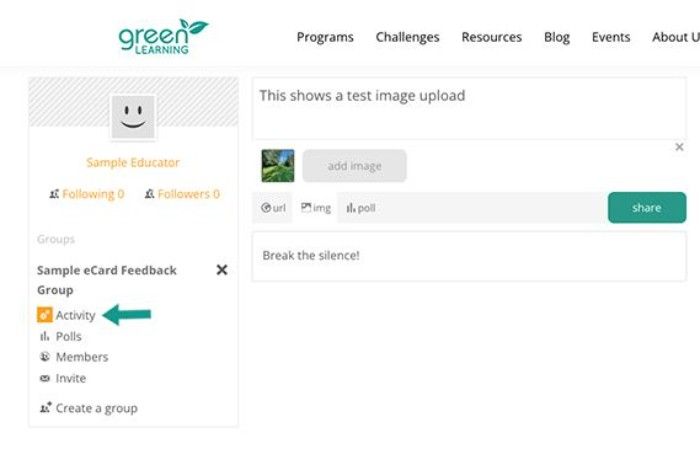
Activity link under private class group.

